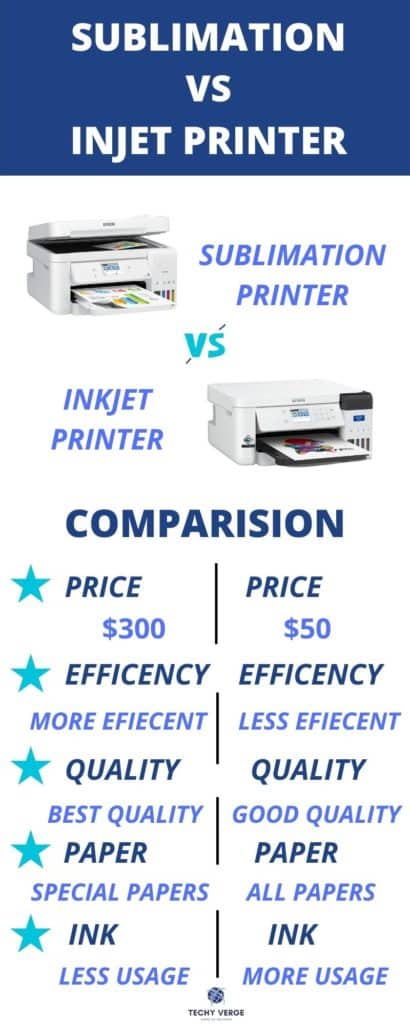In the world of printing, the processes used can greatly impact the quality and functionality of the final product. Two popular printing methods, sublimation and inkjet, stand out with their unique approaches. Understanding the differences between these two processes is crucial for making informed decisions when it comes to choosing the right printer for your needs.
What is Sublimation?
The sublimation process directly converts solid ink particles into a gaseous state under a specific temperature and pressure. This temperature comes using a heat press.
What is Inkjet Printing?
The inkjet printing process involves using tiny, microscopic ink particles that are forced out of the nozzle in the printing process. These ink particles are then allowed to dry for some time.
Difference between Sublimation Vs Inkjet Printer process
Both are unique printing processes and are used at a high rate. We will discuss some important characteristics of these printing processes and their differences.

Print Quality
The essential thing for any printing process is its print quality. In this case, sublimation has its advantage over the inkjet printing process. Compared to inkjet printers, it produces better quality prints.
The reason is that temperature allows the colours in your designs to blend thoroughly in the sublimation process. As a result, you can easily see every colour in your printed designs through a microscope.
On the other hand, inkjet printing does not blend all the colours of your design. The print quality of the document is not affected by this. It is just not good as compared to the sublimation printing process.
Size of Transfer Papers
The transfer papers are required in the printing process for transferring your designs to your materials. However, the size of these transfer papers is also significant in the printing process.
For inkjet sublimation, you can use papers of every size. All the papers can be used in this inkjet printing process from smallest to largest. However, for sublimation, it is not like that.
The sublimation process only involves the use of special-sized transfer papers. To facilitate their placement in the heat press for the proper printing procedure.
Use of Ink
For printing your designs, you always need ink in every printing process. As a result, without using ink, no design can be created.
There is a specific limit on ink usage in both these printing processes. For instance, inkjet printing only involves using these primary 4 colours, which include Cyan, yellow, magenta, and black.
It creates all of your designs just by using these 4 colours. But, the quality of your design is not affected by these colours.
On the other hand, the sublimation process uses only 3 colours. These are known as primary colours. This group has three colours: red, blue, and yellow. It is possible to create thousands of new shades of printing designs by mixing these primary colours.
Print Materials
The use of materials is essential for the printing process. These materials can be anything that you like to print on. However, both these processes have a limit for printing on all materials.
For instance, inkjet can only print on materials like plain papers, cards, envelopes, strip papers, etc. The sublimation process can only print on materials like T-shirts, mugs, bottles, and phone covers.
Price
Price is the main difference that people often look for. The sublimation process is more expensive as compared to the inkjet printing process. You can get a sublimation printer for about $300. But, inkjet can be afforded for just $50.
This is the huge price difference between both these printing processes. You can also print your designs just by using an inkjet printer from the local market. It may cost you around 2-3 cents.
Efficiency
Efficiency tells you how long this process will work without any problems. Thus, it is said that the sublimation printing process is more efficient than the inkjet printing process.
The reason is that, in the sublimation process, ink is not frequently used as compared to the inkjet printing process. Therefore, it lasts more than this other process easily.
Advantages and Disadvantages of the Sublimation process
Pros
- The printer size is relatively small.
- Thousands of shades can be produced to use in printed designs.
- It does not fade away.
- The designs after print do not require any time to dry.
Cons
- It is a slow process, as the heat press requires some time to heat up.
Advantages and Disadvantages of the Inkjet printing process
Pros
- Easily affordable.
- They can print by using transfer papers of all sizes.
- They are responsible for producing high-quality images.
Cons
- The print that it produces may fade away after some time.
Sublimation Vs Inkjet Printer FAQs
Sublimation printers use heat to transfer designs onto materials, while inkjet printers directly transfer designs using ink onto the surface. These processes result in variations in print quality, versatility, and application.
Sublimation printing is superior for high-quality graphics due to its ability to produce vibrant and detailed designs on a wide range of materials, surpassing the capabilities of inkjet printers.
Yes, inkjet printers are commonly used for printing standard text documents in homes and offices. They offer convenience, speed, and cost-effectiveness for everyday printing needs.
Yes, sublimation printers are widely used in industrial settings due to their versatility and ability to produce high-quality prints on various materials. They are often employed in industries such as fashion, home decor, and personalized gifts.
Sublimation printers use heat to transform designs into a gas state, which is then absorbed by the material. Inkjet printers, on the other hand, directly transfer designs using ink droplets onto the surface of the material.
The choice between sublimation and inkjet printers depends on your specific needs. If you prioritize top-notch graphics and versatility across materials, sublimation printing is recommended. For efficient text document printing, inkjet printers are more suitable.
Final Comparison
In conclusion, the sublimation vs. inkjet printer debate highlights the importance of choosing the right printing process for your needs. While inkjet printers excel in standard text document printing, sublimation printers stand out with their ability to produce stunning graphics on various materials.
By considering your requirements and preferences, you can make an informed decision and achieve optimal printing results.
- HP Color LaserJet Pro M283fdw Wireless Laser Printer Review - March 5, 2024
- HP Envy 4520 Wireless All-in-One Color Photo Printer Review - March 5, 2024
- Can Laser Printers Print Color? Affordable Color Laser Printer - February 22, 2024



![Top 100+ FAQs Related to Sublimation Printing & Heat Press [Updated 2024] faqs related to sublimation Printing](https://www.techyverge.com/wp-content/uploads/2022/08/faqs-related-to-sublimation-Printing--150x150.jpg)


